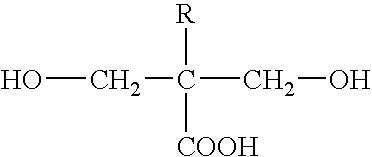Aqueous polysiloxane-polyurethane dispersion, its preparation and use in coating compositions
a technology of polysiloxane and polyurethane, which is applied in the field of aqueous polysiloxanepolyurethane dispersion, its preparation and use in coating compositions, can solve the problems of inability to combine a good soft feel effect and satisfactory solvent resistance on the part of the coating, and the state of the art aqueous products cannot meet the requirements. , to achieve satisfactory solvent resistance, good soft feel effect, good film mechanical properties and adh
- Summary
- Abstract
- Description
- Claims
- Application Information
AI Technical Summary
Benefits of technology
Problems solved by technology
Method used
Image
Examples
first embodiment
[0009] In a first embodiment the invention provides aqueous dispersions of polysiloxane-polyurethanes having an acid number of from about 5 to about 100 mg KOH / g polysiloxane-polyurethane solids, a hydroxyl group content of from about 0.25 to about 6.5% by weight, and a urethane group content (calculated as --NH--CO--O--) of from about 2.0 to about 25.0% by weight, based in each case on polysiloxane-polyurethane solids, wherein the polyurethanes are products, where appropriate at least partly neutralized with bases, of the reaction of
[0010] a) a total of from about 3 to about 25% by weight of at least one linear polydimethylsiloxanediol of the molecular mass range about 1,500 to about 10,000,
[0011] b) A total of from about 15 to about 90% by weight of at least one further difunctional polyol, selected from the group consisting of
[0012] i) hydroxyl-containing polycarbonates of the molecular mass range about 400 to about 6,000,
[0013] ii) hydroxyl-containing polyetherpolyols of the mol...
examples
[0093] In the examples below all percentages are by weight. The pH values were determined in accordance with DIN 53 785 following dilution with distilled water to a solids content of 10% by weight.
preparation examples
a) Preparation Examples
Example 1
[0094] (Inventive)
[0095] A reaction vessel with stirring, cooling, and heating means was charged with 84.0 g of the polyester Oxyester T1136 (hydroxyl content about 3.2%, Degussa AG), 24.0 g of the hydroxyalkyl-modified polydimethylsiloxane Tegomer.RTM.H--Si 2311 (Mw=2,500 g / mol, Goldschmidt AG), 16.8 g of 2,2-bis(hydroxymethyl)propionic acid (DMPA) and 54.0 g of N-methylpyrrolidone (NMP) under nitrogen and this initial charge was heated to 60.degree. C. and homogenized.
[0096] Then 105.7 g of isophorone diisocyanate (IPDI) and 0.2 g of dibutyltin dilaurate (DBTL) were added and the mixture was stirred at 90.degree. C. until (about 1 h) the theoretical isocyanate content of about 8% had been reached (prepolymer (I)). 12.0 g of 1,4-butanediol were added to this reaction mixture which was then stirred at 90.degree. C. until (about 1 h) the theoretical isocyanate content of about 3.9% had been reached (prepolymer (II)).
[0097] Then 27.6 g of trimethylolpro...
PUM
| Property | Measurement | Unit |
|---|---|---|
| temperature | aaaaa | aaaaa |
| temperature | aaaaa | aaaaa |
| temperature | aaaaa | aaaaa |
Abstract
Description
Claims
Application Information
 Login to View More
Login to View More - R&D
- Intellectual Property
- Life Sciences
- Materials
- Tech Scout
- Unparalleled Data Quality
- Higher Quality Content
- 60% Fewer Hallucinations
Browse by: Latest US Patents, China's latest patents, Technical Efficacy Thesaurus, Application Domain, Technology Topic, Popular Technical Reports.
© 2025 PatSnap. All rights reserved.Legal|Privacy policy|Modern Slavery Act Transparency Statement|Sitemap|About US| Contact US: help@patsnap.com

